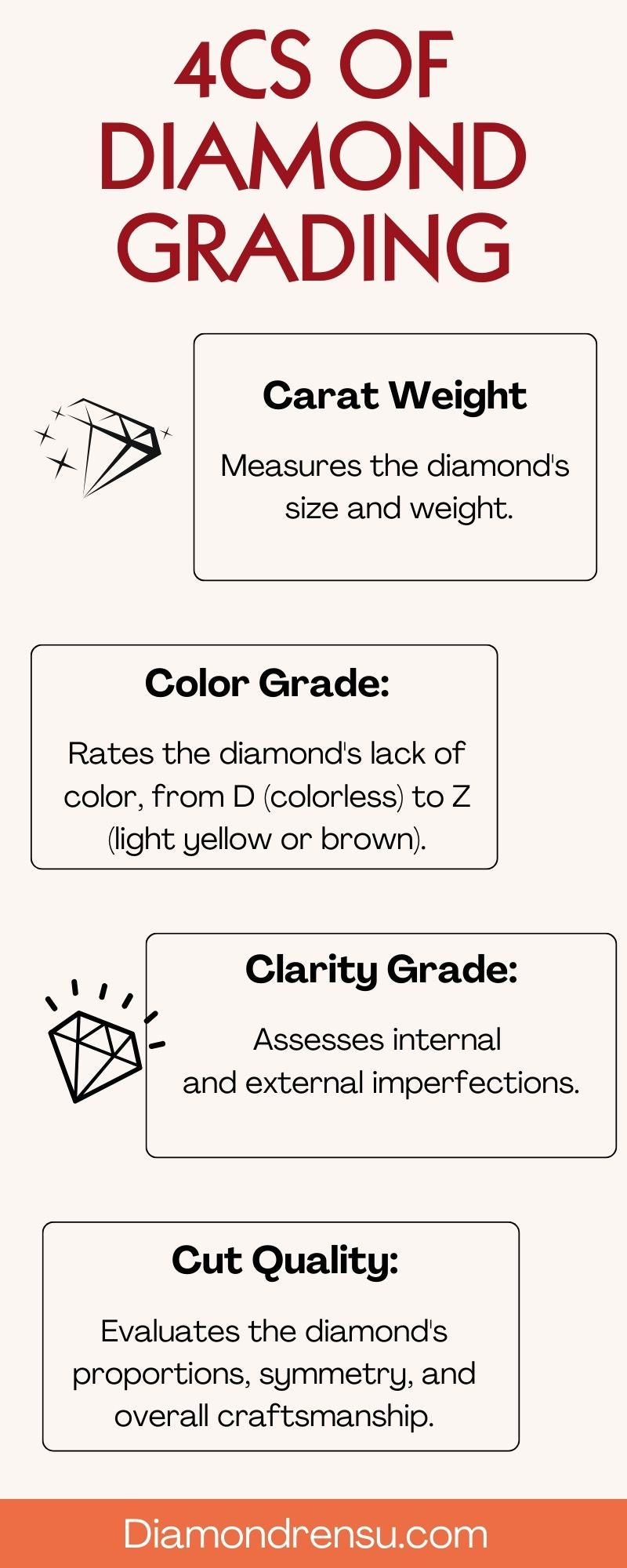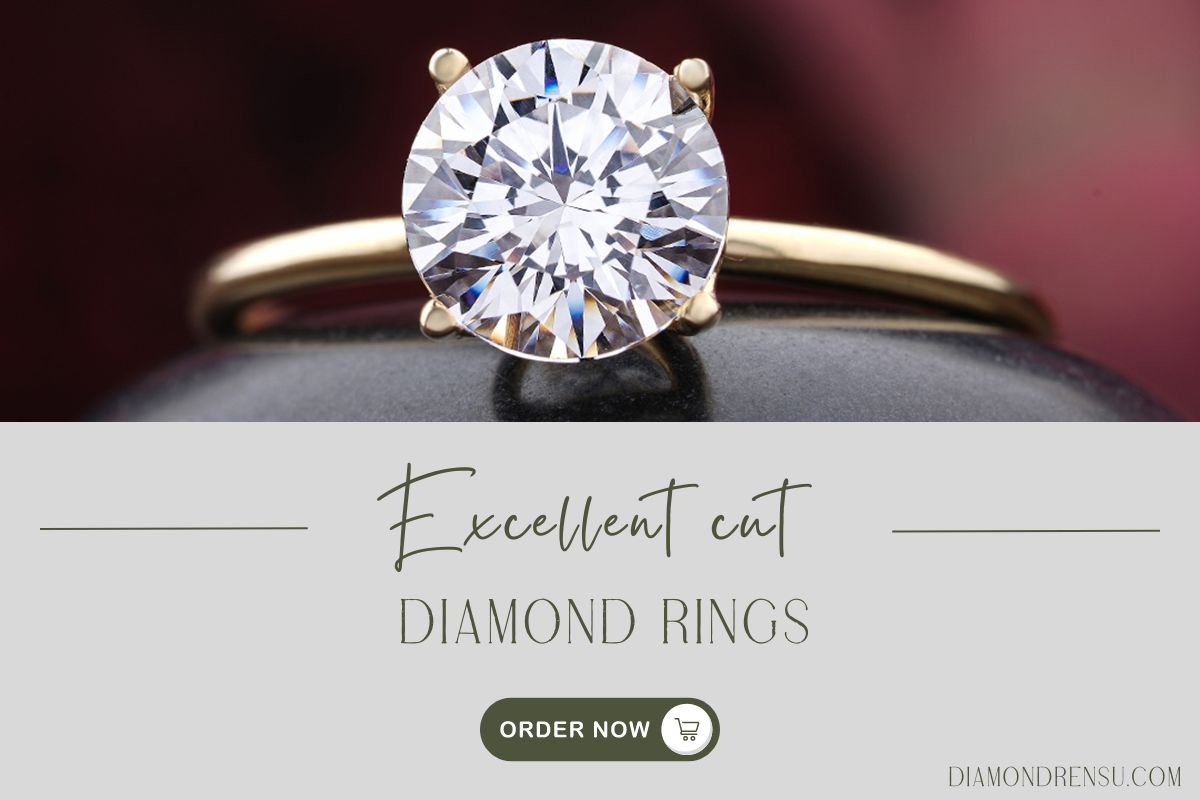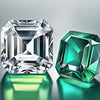
How to Tell if a Diamond is Real with a Flashlight: A Simple Testing Method
Determining the authenticity of a diamond can be both fascinating and practical, particularly when we don't have immediate access to professional appraisal services. We often rely on a variety of at-home tests to discern a real diamond from a fake. Using a flashlight is one such method that's accessible to most of us. While this test isn't definitive, it provides a quick and easy check that can suggest whether further verification might be needed.
Dazzle More, Pay Less – Your Perfect Ring Awaits!
When we shine a flashlight on a diamond, we're observing how the stone interacts with light. A real diamond refracts light in such a way that it sparkles with a gray and white brilliance, and can also cast rainbow colors onto a surface. The way a diamond reflects light is unique due to its high refractive index. On the other hand, materials that imitate diamonds tend to reflect light differently, often lacking the same scintillating effect.
However, it's crucial for us to approach these tests with a degree of skepticism. Not all diamonds will react in the exact same manner, as cut and setting can influence the outcome. Likewise, some high-quality synthetic diamonds may display similar optical properties to natural diamonds. Thus, while using a flashlight can be a handy preliminary check, for us to certify a diamond's authenticity, consulting with a professional is always recommended.
Understanding Diamonds
Before we examine how to determine a diamond's authenticity, it's crucial to understand what defines a diamond and the differences between natural and synthetic varieties. We'll specifically look at the characteristics that experts use to evaluate diamonds, including those rated by such entities as the GIA, AGS, and IGI.
Natural vs. Synthetic Diamonds
Natural Diamonds
🌍 Formed over billions of years under natural conditions
⏳ Mined from the Earth
💎 Unique with natural inclusions and variations
💰 Generally more expensive due to rarity
Synthetic Diamonds
🏭 Created in laboratories within weeks
🔬 Produced using high-pressure, high-temperature (HPHT) or chemical vapor deposition (CVD) methods
🌟 Can be made to be virtually flawless
💵 Typically less expensive than natural diamonds
Natural diamonds are formed under high pressure and temperature conditions deep within the Earth's mantle over billions of years. In contrast, synthetic diamonds, which include lab-grown diamonds, can be produced in a much shorter time frame using advanced technological processes that mimic natural formation conditions. The Gemological Institute of America (GIA) and the American Gem Society (AGS) both certify natural and synthetic diamonds, ensuring their characteristics meet specific standards. It's essential to recognize that while synthetic diamonds have the same chemical and physical properties as natural diamonds, they differ significantly in their origin: one is mined from the earth, whereas the other is crafted in a controlled environment.
|
Natural Diamonds |
Synthetic Diamonds |
|
|
Origin |
Formed in Earth's mantle; mined |
Created in labs using HPHT or CVD methods |
|
Value |
Generally higher due to rarity |
More affordable |
|
Certification |
Often certified by GIA, AGS, IGI |
Also certified but may have different inscription |
Evaluating Diamond Characteristics

When we evaluate diamonds, we pay close attention to the four Cs: carat, cut, color, and clarity. Carat refers to the weight of the diamond, and one carat is equal to 200 milligrams. The cut of a diamond affects its brilliance and is often graded from Excellent to Poor. Color in diamonds ranges from colorless to yellow or brown tints, with the most valuable being completely colorless. Clarity is the measure of inclusions and blemishes; the fewer the imperfections, the more exquisite and costly the diamond.
Beyond the four Cs, we look for other attributes to ascertain a diamond's authenticity, such as how it interacts with light, which is pertinent to methods like the flashlight test. Laboratory-grown diamonds, for example, often reflect blue light under ultraviolet light. Alternatively, simulants such as cubic zirconia, moissanite, white sapphire, and white topaz can be differentiated from diamonds through tests focusing on their optical properties, with the dot test being a common example.
Inclusions, the internal characteristics of a diamond, and blemishes, which are surface imperfections, are often uniquely indexed, similar to a natural fingerprint and can be verified by a diamond expert or by comparing certificates provided by reputable institutions like GIA, AGS, or IGI.
It's through understanding these nuances of diamonds that one can move on to accurately assess whether a diamond is real or synthetic using various tests, including but not limited to the use of a flashlight.
Preliminary Home Tests

In our experience, preliminary home tests provide initial insights on whether a stone is a diamond. We'll guide you through visual inspections and basic test methodologies you can perform with items found at home.
Visual Inspection with a Magnifying Tool
For an effective close-up examination, we recommend using a magnifying glass or a jeweler's loupe. Diamonds usually contain natural imperfections called inclusions, which are often not found in synthetic counterparts. When inspecting with a magnifying tool:
- Look for small imperfections within the stone these could be a sign of a real diamond.
- Observe the edges: diamonds should have sharp, crisp edges, whereas other gemstones might have softer, rounded edges.
- Take note of the stone's sparkle genuine diamonds produce a distinctive sparkle that is often imitated but not matched.
Water and Fog Test Methodologies
The Water Test
Given diamonds are dense, they sink quickly when dropped into water. Here's how to conduct the water test:
- Fill a glass with water.
- Carefully drop the stone into the glass.
- Observe: A real diamond should sink immediately.
While this test is not entirely foolproof, it provides a quick and easy indication of density.
The Fog Test
This simple method tests a diamond's ability to disperse heat. To perform the fog test:
- Hold the stone between two fingers.
- Breathe out on it as you would on a mirror to fog it up.
- Watch how quickly the fog dissipates:
- A real diamond should not stay fogged for more than a couple of seconds due to its heat dispersal properties.
It's important to be aware that while home tests like water and fog can be suggestive, they are not as reliable as professional evaluations. These DIY methods should serve as preliminary checks to determine whether further expert analysis is required.
Using Light and Reflectivity

When we examine diamonds, their interactions with light are determinative in assessing authenticity. Reflectivity and light patterns provide us critical insights, especially during the Flashlight Test and while observing fluorescence under UV light.
| Aspect | Description |
|---|---|
| Brilliance | 💡 Measures the amount of white light reflected from the diamond |
| Fire | 🔥 Dispersion of light into various colors of the spectrum |
| Scintillation | ✨ Sparkling effect seen when the diamond is moved |
| Reflectivity | 🔍 Internal and external reflection of light that contributes to a diamond's overall appearance |
| Clarity | 🔬 Inclusions and blemishes affect how light travels through the diamond |
| Cut Quality | ✂️ Precision of the cut enhances light performance and overall sparkle |
Flashlight Test Execution
To perform the Flashlight Test, follow these steps:
- Darken the room to maximize the visibility of the light patterns.
- Hold the diamond in question close to a lamp or a bright flashlight.
- Observe the way light exits the diamond.
A real diamond has a high refractive index, resulting in a unique light pattern called scintillation. We should see light reflecting off the diamond's surfaces and dispersing into a scintillating sparkle, often resembling rainbow colors. The intensity of this sparkle, which correlates with the diamond's brightness and reflectivity, helps distinguish a genuine diamond from a counterfeit. If the light simply passes through without this lively dance of colors, we may be looking at a high-quality imitation.
Understanding Fluorescence and UV Light
The presence of fluorescence in a diamond can be seen under UV light. To assess this:
- Expose the diamond to ultraviolet rays from a UV lamp.
- Look for a glow, which could be blue fluorescence or gray fluorescence, indicating the stone's response to UV light.
Not all diamonds exhibit fluorescence; those that do will glow to some extent when under a UV light test. Due to the different ways diamonds can be formed, fluorescence can range from nonexistent to very strong. Generally, a real diamond often shows some degree of blue fluorescence, which may enhance or detract from its appearance, depending on the individual stone's characteristics. Although not a definitive test alone, when combined with the flashlight test, it aids in our overall assessment.
Technical Gemstone Tests

Refractive Index Test
🔬 Measures how light bends as it passes through the gemstone
🌟 Helps identify and distinguish gemstones
📏 Requires a refractometer
Specific Gravity Test
⚖️ Determines the density of the gemstone
💧 Uses a hydrostatic balance
📊 Helps identify the type and authenticity of the gemstone
Hardness Test
🪨 Measures resistance to scratching
🔨 Uses the Mohs scale of hardness
💎 Identifies durability and type of gemstone
UV Light Test
💡 Exposes gemstones to ultraviolet light
🌈 Reveals fluorescence and phosphorescence
🔍 Helps in distinguishing natural from synthetic gemstones
In our comprehensive guide, we focus on objective technical tests that assess a diamond's authenticity based on physical properties such as thermal conductivity and density.
Assessing Gemstone Density and Weight
Density Test: We begin by employing a simple water test to assess a diamond's density. Genuine diamonds have a high density and will sink rapidly when dropped into water, whereas many counterfeit stones will float or sink more slowly. Here's how to perform this test:
- Fill a glass with water.
- Carefully drop the gemstone into the glass.
Observation: A real diamond should sink to the bottom due to its density.
This method, while easy, is not foolproof, as some fakes with similar densities can also pass this test.
Weight Comparison: For a more precise evaluation, we compare the weight of the gemstone to known weights of real diamonds.
- Weigh your gemstone using a precise digital scale.
- Compare the results to the standard weight of real diamonds of a similar size.
Real diamonds are typically heavier than most common simulant stones like cubic zirconia due to their density.
Moving on from weight-based tests, thermal conductivity can be a revealing indicator, as diamonds conduct heat efficiently. In a professional setting, we might use a thermal conductivity probe to distinguish real diamonds from fakes because diamonds disperse heat quickly.
Lastly, the scratch test utilizes the diamond's hardness characteristic. Diamonds rank at the top of the Mohs hardness scale and should easily scratch any other gemstone. However, this test risks damaging both the diamond and other gems, so we recommend it only be carried out by professionals.
Advanced Testing Methods

When considering the authenticity of diamonds, advanced testing methods using professional tools are imperative for accurate identification.
Professional Tools for Accurate Identification
We understand the importance of reliable validation when it comes to diamonds. Professionals in the field use a range of sophisticated equipment to determine whether a diamond is real. For instance:
- Microscope: A jeweler's microscope is a key tool in examining a diamond for its characteristics. These microscopes can magnify the gemstone up to 100 times, revealing inclusions, unique marks, and confirming the craftsmanship consistent with a natural diamond.
- Thermal Conductivity Probes: Diamonds have high thermal conductivity. As such, these probes can differentiate between diamonds and other materials that may resemble them visually.
- Reflectivity meters: Diamonds reflect light in unique ways. Professionals use reflectivity meters to gauge how much light bounces off the stone, which is an indicator of authenticity.
Certification from organizations like the Gemological Institute of America (GIA), the American Gem Society (AGS), or the International Gemological Institute (IGI) serves as a testament to a diamond's authenticity. These certificates offer a detailed analysis of a diamond's characteristics from experts in the industry.
Reputable jewelers will always have these professional tools at their disposal. Trustworthy establishments are the best place for consumers to have their diamonds tested, ensuring peace of mind about their gemstone's authenticity.
What to Look for in Jewelry Settings

When we examine jewelry settings, particularly for engagement rings, we're looking for signs that reflect the craftsmanship and the quality of materials indicative of high-quality jewelry.
Metal Quality Indicators
-
Hallmarks: We check for hallmarks inside the ring that identify the type of metal. For example:
- Platinum rings should be marked as '950 Plat' or 'Pt950'.
- Gold rings are often marked with '18K', '14K', or other purity indicators.
-
Craftsmanship: High-quality jewelry settings are crafted through meticulous processes including cutting, drilling, grinding, and polishing. These processes result in a finish that's smooth to the touch and visually flawless.
-
Prongs and Mounts: A jeweler's skill is also evident in the prongs and mounts of a setting. They should be:
- Sturdy and well-aligned, securely holding the diamond.
- Evenly spaced and shaped to enhance the diamond's appearance without overshadowing it.
-
Metal Durability:
- Platinum: This dense, durable metal is resistant to wear, making it a popular choice for engagement rings.
- Gold: Whether it's white, yellow, or rose gold, the metal should exhibit a high-quality finish without signs of hasty workmanship.
We recognize that a precious stone like a diamond is often set with the care and precision that match its value. The metal's quality and the setting's craftsmanship are strong indicators of the overall quality of a piece of jewelry.
Finalizing Authentication
When it comes to confirming the authenticity of diamonds, our focus shifts from self-assessment methods to professional evaluation. We understand that tools like flashlights provide preliminary insights but they aren't definitive.
Consulting with Diamond Experts
We seek the expertise of certified gemologists, particularly those accredited by the Gemological Institute of America (GIA). These professionals have the requisite knowledge and tools to determine authenticity with certainty. When we present a loose diamond for evaluation, a jeweler or diamond expert will perform a series of tests, including but not limited to:
-
Visual Inspection: Using a jeweler's loupe, they will look for natural inclusions and examine the diamond's craftsmanship and wear.
-
Instrument Analysis: Advanced gemological instruments measure the diamond's responses to light and heat, confirming its material properties.

The conclusion drawn by these diamond experts is crucial. Authenticity is not just a matter of appearances to the naked eye or under a flashlight; it is a matter of detailed and professional analysis.
Also Read
Frequently Asked Questions
In this section, we cover common queries about using simple techniques to discern real diamonds from imitators, providing you with easy-to-follow methods and signs to look out for.
What are the visual indicators to identify a real diamond by eye?
When identifying a real diamond by eye, observe its brilliance. Real diamonds refract light in such a way that they offer exceptional sparkle, with sharp and quick reflections, while fakes often have a more muted sparkle or rainbow colors that are less defined.
Can the way a diamond behaves with a mirror help determine if it's authentic?
Yes, the mirror test can sometimes help. When you place a diamond on top of a mirror, a genuine stone will not cast a reflection or show its bottom through the mirror due to its high refractive index.
What home methods are there to test if a diamond is genuine?
Common home tests include the water test, where a real diamond will sink due to its density, and the fog test, where breathing on a real diamond won’t hold the fog for more than a moment due to the stone's effective heat dissipation.
How can UV light be used to verify the authenticity of a diamond?
Under UV light, many real diamonds will emit a blue glow, but not all diamonds react this way. The absence of a blue glow does not definitively mean the diamond is fake, but its presence is a favorable sign towards authenticity.
Is there a way to tell if a diamond is real without specialized testing equipment?
Observing the diamond for its refractive properties by looking at it atop a dot on a piece of paper is a method that requires no special equipment. A real diamond will scatter so much light that the dot will not be visible when looking through the stone.
How can you test a diamond that's already mounted to ensure it's real?
Testing a mounted diamond involves checking for refractivity; mounted stones should not show through under light if they're real. The setting itself can also give clues; finer materials like platinum and gold are more likely to hold real diamonds, though this is not a foolproof indicator.
Checkout some of our top collections:
Leave a comment
Please note, comments must be approved before they are published.










